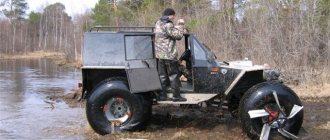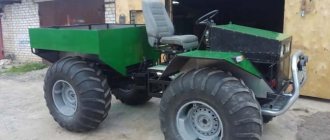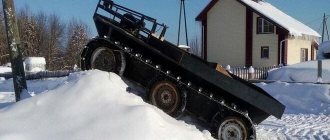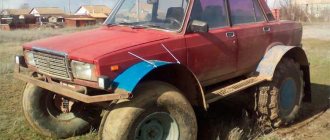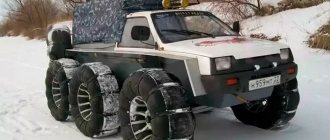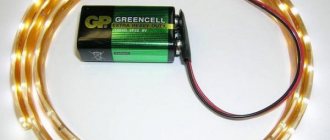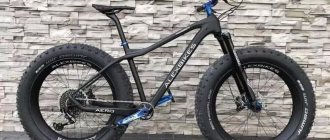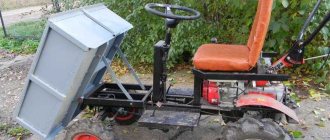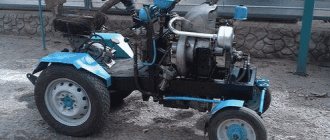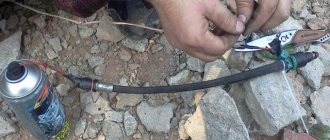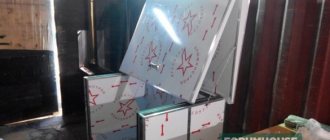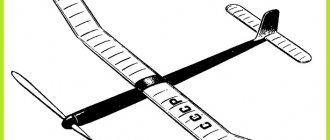Karakat is an all-terrain vehicle with a sectional frame equipped with an articulated joint that allows the halves to deviate in different planes. The equipment has increased cross-country ability, and its simple design allows you to assemble the vehicles yourself using parts from production cars and motorcycles. There are all-terrain vehicles with a fracture-type frame built by small private enterprises.
Karakat fracture with Lifan engine
Initially, the creator of the unusual vehicle wanted to make a three-wheeled moped. It was assumed that it would have increased cross-country ability. However, then the author decided to sell his all-terrain vehicles. And he had to focus on the needs of customers.
To make a model of an all-terrain vehicle, you will need the following spare parts and consumables:
- Lifan engine 6.5 hp;
- Honda gearbox;
- scooter variator;
- resinous fiberglass;
- moped generator;
- muffler with wide cross-section;
- corner 32 mm;
- conveyer belt.
Initially, the main ways of constructing the karakat were developed. The inventor immediately abandoned the chain transmission. This is due to insufficient reliability. Alloy wheels were selected, the size of which was 15 inches. They have more mass than homemade ones. However, they are distinguished by reliability and better external characteristics.
Design features
A special feature of the carakat design is its layout, the motor and gearbox are located on the front of the frame. The transfer gearbox transmits torque to the front wheels; a separate shaft running inside the hinge is used to drive the rear wheels. Steering rods are provided, which are attached to hydraulic cylinders or a mechanism, and a standard wheel and pedal assembly are used for control.
Minimum Specifications
Technical parameters of all-terrain vehicles:
- length - from 3000 mm;
- width - from 1500 mm;
- height - from 1200 mm;
- number of passengers - from 4 people;
- load capacity - from 300 kg;
- weight - from 600 kg;
- speed on the highway - from 25 km/h;
- speed on water - from 2 km/h.
Fracture swamp vehicles with Lifan engine
After determining the layout of the all-terrain vehicle, you can begin turning work. To do this, follow the following instructions step by step.
You need to prepare a four-stroke variator from a scooter. Its convenience lies in the easy regulation of clutch speed and operation. Such gearboxes are installed on engines with power up to 14 hp.
Then it’s worth tackling the caracat’s rear axle and cones. Then you can move on to making flanges for the wheels.
It is advisable to make the seat using standard technology. Coat the mold with wax and place fiberglass on it. It must be impregnated with resin several times. The hardened seat should be removed from the mold, bolted to the ATV frame, and painted to improve appearance.
The gearbox must be taken from a Honda. Although you can use the transmission from Oka. The gearbox must be installed on the caracat frame.
It is advisable to use BMW wheels. Install a generator from a moped and a large cross-section muffler.
The frame needs to be made from a 32 mm corner, 1 m of which weighs 1.2 kg. And 1 m of a 25x2 square pipe has a mass of 100 g less. This means that if desired, the all-terrain vehicle can be made lighter. This reduces the reliability and strength of the karakat.
In transition mode, the carburetor sometimes malfunctions. It will take some time to perfect the part. It took the creator 2 days to complete this.
The rev limiter must be disabled before installing the engine. To make wheels, use a conveyor belt. Cut 12 segments at its edges, and leave 13 for gluing. Screw all this to the disk. A 20 cm overlap was glued along the treadmill. The rear tires should be made of single-ply cord and running tires. For better adhesion of swamp vehicle tires to the Lifan engine, it is necessary to cover them with belts.
Increasing power with a go-kart is not practical. It's much easier to buy a new motor. The ratio of pulleys from the gearbox to the variator is 1:3. For off-road use, you need to engage first gear. On flat surfaces it can be maximum.
Finally, all that remains is to install the flanges on the wheels. You can use cones instead. It is important to ensure that there are no backlashes by tightening the terminals. It is permissible to drill and screw in a bolt that will become a fastener. It must be brought out to prevent breakage.
The bearings are installed in bushings located on the shaft. This is necessary to keep it from moving.
Light all-terrain vehicle tricycle | DIY FRIEND
Dear visitors to the “Homemade Friend” website, from the material presented by the author, you will learn how you can independently assemble a lightweight three-wheeled caracat in your garage. Today, all-terrain vehicle construction is quite well developed among hunters and fishermen; guys assemble their off-road vehicles right in their garages from the spare parts and parts they have, it turns out very well, and most importantly, on a budget, which is important in our time.
Due to the nature of their activities, fisherman and hunters have to travel long distances through complete off-road conditions, ravines, snowdrifts, weeds, and water. And thanks to the all-terrain vehicle, everything becomes much easier and the next trip for prey turns into a pleasant walk.
The author has been manufacturing light all-terrain vehicles for quite some time now, mainly tricycles with rear-wheel drive and a scooter engine that has a variator, which is quite convenient when driving off-road. The weight of the all-terrain vehicle is about 200 kilograms. The wings are made of fiberglass.
So, let's look at what exactly is needed to assemble an all-terrain vehicle? We will also analyze all the stages of creating a tricycle.
Materials
- Engine "Lifan 6.5 l/s
- Gearbox from Honda CITY
- scooter variator
- generator
- fiberglass
- conveyer belt
- wide section muffler
- corner 32 mm
- professional square pipe
- alloy wheels R-15
- headlight
Tools
- welding machine
- lathe
- drill
- emery
- set of wrenches
- hammer
- screwdriver
- knife
- brush
- pulivizer
- compressor
The process of assembling a lightweight caracat with your own hands.
The master carried out all his work in his garage, where there are all the necessary tools and machines for working with metal and its processing. The author prepared a variator for a scooter. Next, the rear axle and cones are bored on a lathe. I installed the hub on the axle. The author made the wings and seat from fiberglass and epoxy resin. First, a master model was made and the base was created from it. A layer of fiberglass is applied, coated with epoxy resin, and so on in several layers. After drying, the edges and irregularities are cut off and the surface is sanded. Gearbox from HONDA CITY Rear axle and drive. Wheels and rims from BMW are installed. Generator from a moped. The original carburetor was replaced with a starter from a tractor. The all-terrain vehicle frame is welded from 32 mm angle iron. As mentioned above, the carburetor was used from a tractor starter and showed good performance. The axle has grooves for a key. Bearings used during assembly. The drive is on the rear axle. Well, our author has come up with such a wonderful three-wheeled all-terrain vehicle. The weight is about 200 kg, it belongs to the class of light all-terrain vehicles, perfect for a fisherman or hunter, cutting through off-road spaces. As they say, “For an all-terrain vehicle, you don’t need a road, you only need a direction)))
Thank you very much for your attention!
source
www.samodelkindrug.ru
Three-wheeled all-terrain vehicle with Lifan engine
The three-wheeled caracat is an off-road vehicle. An all-terrain vehicle is used to transport goods. The caracat can accommodate 2 people. However, if necessary, more passengers can sit in the back on a small bench.
Homemade lightweight all-terrain vehicle with a breaking frame on low-pressure tires: photo of production with a detailed description.
I would like to note right away that the all-terrain vehicle turned out to be quite original. The tipping-type frame allows it to easily maneuver over rough terrain, low-pressure tires distribute the weight of the vehicle well, increasing the area of contact points with the surface, which allows it to move freely through swampy terrain, sand or snow.
The all-terrain vehicle is equipped with a simple and universal Lifan engine with a power of 6.5 l/s. The engine power is quite enough, because the weight of the all-terrain vehicle is only 200 kg.
The design of the all-terrain vehicle is collapsible; in half an hour it can be partially disassembled, loaded onto a small car trailer and transported.
Next, consider a photo of the step-by-step construction of an all-terrain vehicle with a description.
The following materials were used to assemble the all-terrain vehicle:
Advantages and disadvantages of homemade products
The main advantages of the breaking frame technique:
- low cost compared to serial wheeled ATVs;
- positive buoyancy of equipment due to tubes and tires;
- reduced fuel consumption;
- simple design of engine and transmission units.
Disadvantages of homemade or small-scale all-terrain vehicles:
- low reliability of homemade units made from scrap materials without calculating the safety factor;
- insufficient maneuverability and a rigid chassis, which lacks damping units;
- Difficult storage of equipment due to the increased dimensions of the all-terrain vehicle;
- destruction of tire material under the influence of ultraviolet radiation.
All-terrain vehicle assembly.
Two parts of a fracture-type frame were welded from profile pipes.
On the frame, the author installed a Lifan engine with a power of 6.5 l/s, a modified gearbox with drive shafts and hubs.
The frame fracture assembly itself is made from a VAZ 2101 steering knuckle, hub and ball joints. Steering from VAZ 2108.
The front discs are mounted on ZAZ axles, the rear discs are mounted on VAZ 2108 hubs.
The rims were welded to a width of 300 mm for wheels 1070 x 400 mm. The tires on the tubes are made of PVC fabric, and lugs are made.
Torque from the engine is transmitted by a chain transmission with a pitch of 12.7 to the intermediate shaft and then to the box from ZAZ. The UD-2 clutch is installed through the plate to the GAZ 51 gearbox.
The differential in the gearbox was not blocked, the all-terrain vehicle has a low mass. The transmission has a triple reduction:
- Gearbox 1:2.
- Reducer – intermediate shaft 1:3.
- Intermediate shaft - input shaft 1:2.7.
The peculiarity of the all-terrain vehicle is its low weight, only 200 kg, thanks to which the all-terrain vehicle floats well on the water.
- Length 2800 mm.
- Width 1450 mm.
- Height – 1400 cm.
In the photo: the author of the homemade product, Nikita Shchukin.
In the video, the author demonstrates the capabilities of his vehicle.
An interesting caracat model with a tipping-type frame design and all-wheel drive on OI-25 tires. The weight of the all-terrain vehicle was about 450 kilograms. The all-terrain vehicle is initially designed for two people and the transportation of cargo, but if desired, you can also take passengers into the back, since there is a specialized bench there.
Materials and units used in the construction of this all-terrain vehicle: 1) Oi-25 tires 2) profile pipe size 50x50x2 3) drive from VAZ 2110 4) Lifan engine 13 hp. 5) large pulley drive from VAZ 2109 6) hub from VAZ 2108 7) steering rack from Lada Kalina steering column from VAZ 2105 9) brake disc from VAZ 2108 10) hand brake from VAZ 2108 11) clutch cylinder from VAZ 2105 12) cable clutches from vaz 2110
5) large pulley drive from VAZ 2109 6) hub from VAZ 2108 7) steering rack from Lada Kalina steering column from VAZ 2105 9) brake disc from VAZ 2108 10) hand brake from VAZ 2108 11) clutch cylinder from VAZ 2105 12) cable clutches from vaz 2110
Let us consider in more detail the stages of construction of the all-terrain vehicle, as well as the main components of its structures.
To begin with, the author decided to weld the all-terrain vehicle frame from a profile pipe measuring 50 by 50 by 2 mm.
In order to strip the oi-25 tires, the author even made a homemade winch; complete stripping took a whole month and a half.
The fracture unit is made according to the K-700 principle.
The fork seat was machined to match the diameter of the drive pipe. The drive itself was cut to the required size, and then the fork was installed in it and the entire structure was welded. Thus, one side was inserted into the gearbox grenade, and the flange was screwed to the front axle of the all-terrain vehicle. The second drive, accordingly, goes to the second grenade and flanges to the fracture unit of the all-terrain vehicle frames.
Then the author began work on the all-terrain vehicle's transmission.
After that, the author installed the frame on the wheels and installed a Lifan engine with a power of 13 hp. A belt clutch was also created. The large pulley drive from the VAZ 2109 was also taken along with external grenades, and one grenade was modified so that it could fit into the input shaft of the gearbox.
More details about the work on the grenade: it was printed out and the separator with the balls was removed, after which the splined shank was cut off, and a splined bushing was cut out of the clutch disc. then a hole was made to fit the bushing. After this, the bushing was installed in the grenade and subjected to welding. welding was carried out according to the principle of how a frame fracture unit is welded.
To make the driven pulley, a hub from a VAZ 2108, a wheel bearing and a retaining ring for this bearing were taken. A new support box was machined for this bearing and the support legs were welded to the bearing itself. After which the parts are assembled together. The pulley itself is put on the car wheel and secured with wheel bolts.
Then a steering rack from a Lada Kalina and the steering column itself from a VAZ 2105 were installed. The steering cardan shafts were connected to each other.
There are several ways to make karakat with your own hands. Ready-made mechanisms are used as a basis: a chainsaw engine, an Ant scooter, a UAZ car, etc. A homemade all-terrain vehicle floats on water and does not damage vegetation when moving on land.
Caracata 4x4 all-terrain vehicles from 130 thousand rubles in stock. Fracture swamp vehicles are available and can be ordered at manufacturer prices in the Master Techno catalog.
The Master Techno company has been selling and testing caracats from a variety of manufacturers for a long time. We will always tell you about all the advantages and disadvantages of the design of different models and help you make the right choice of caracat or select a KIT kit for assembly.
History of the creation of caracats:
The very first caracats appeared in the late 80s in the Vologda region and were initially three-wheeled and built on the basis of Voskhod and IZH Planet motorcycles. Craftsmen modified the motorcycle frame to accommodate the installation of cameras from trucks or lightweight wheels from agricultural machinery (ROU-6 - organic fertilizer spreader).
Thanks to large wheels and low specific pressure, the vehicle performed well in swampy areas, but at the same time it was inferior in cross-country ability in snow, due to the lack of all-wheel drive and aggressive wheel tread. The front wheel rested on the snow, and the all-terrain vehicle was helplessly grinding with its rear wheels. The problem was solved by installing a ski instead of the front wheel, but still full-fledged driving on snow was not possible.
Construction of a modern classic caracat 4x4
Over time, the design of the all-terrain vehicle has undergone significant changes and today the classic karakat is not a 3-wheeled vehicle with a motorcycle donor, but a 4-wheeled vehicle with an independent fracture-type frame (the fracture unit uses a steering knuckle from UAZ or Shkvorneva’s own design). General purpose engine Lifan, Honda, Loncin, Zongshen. And a gearbox from a VAZ car. Instead of tubes, the so-called “Trims” are used as wheels; this is when a tire from an army truck is taken and by removing (stripping) from 40% to 60% of the cord, a lightweight low-pressure wheel with an aggressive tread is obtained. The tread pattern itself can be anything the customer desires. Popular ones are herringbone, gear - symmetrical and asymmetrical.
Let us consider the design of the karakat in more detail with a description of all the nodes used:
1. All-terrain vehicle frame and turning mechanism.
It is based on two half-frames connected to each other by a breaking breaking mechanism (That’s why the second name for caracats is fracture). In this case, both sections of the frame are independent of each other in terms of movement in the longitudinal plane and therefore all 4 wheels are always in contact with the surface. This is precisely what achieves the phenomenal cross-country ability of the caracat. The fracture unit itself is used in 2 types:
- 1. Ball - Steering knuckle from UAZ and similar military SUVs. It is characterized by its simple design, ideal for lightweight devices, but relatively more difficult to maintain and requires attention.
- 2. Shkvornevoy – (like the T150 tractor). A more reliable unit, but demanding on the quality of manufacturing and design, therefore it is used by larger manufacturers as their own development. The knot can withstand higher loads and is therefore used when creating heavy carats with powerful engines.
As a rule, the steering rack from front-wheel drive cars of the Volzhsky Automobile Plant is used as a turning mechanism.
At the customer's request, electric or hydraulic power steering is also installed. But the issue of its use is controversial. On the one hand, steering comfort increases, and on the other, due to damping, the load on the steering rod increases and the maneuverability through carpet swamps and very rough terrain decreases.
2. Engine and Transmission Caracats:
General Purpose Engines
- These are universal power units developed by Honda in the 1980s and have successfully proven themselves in a wide variety of equipment (Power, construction, utility, etc.). The advantages of this family of engines are a simple and reliable starting system, high thrust at low speeds and amazing reliability. And even despite the fact that most of this family is produced in factories in China, reliability has not suffered much from this. The most popular manufacturers from China are Lifan, Loncin and Zongshen.
Caracat transmission
differs in the type of gearbox used and the implementation of the clutch (Transmitting torque from the engine to the gearbox and axles). The simplest and most accessible shifts use a “motor-block drive” using 2 pulleys of one or three belts and a pressure roller for a 4-speed gearbox from a VAZ Classic (VAZ 2101-2107). The roller in this case acts as a clutch. The advantages of this solution are their simplicity and maintainability, but the disadvantages are the constant adjustment of the tension roller and the need for high-quality belts, which are “consumables” and must be carried with you.
The automobile disc clutch at the gearbox is more reliable and advanced; as an alternative, the Safari variator from the Buran snowmobile is also used - but not all manufacturers can properly organize the operation of the variator transmission.
In general, we can distinguish 3 working schemes for constructing a transmission:
- 1. The tension roller at the gearbox
is the simplest, most accessible and repairable (but only for all-terrain vehicles whose weight does not exceed 500 kg and whose engine power is 17 hp) - 2. Automotive clutch paired with a variator
– excellent dynamics, reliability and cross-country ability in medium and severe operating conditions. (Not all manufacturers can constructively correctly use this unit).
Golden mean
– excellent for all-terrain vehicles weighing from 500 to 800 kg. and power from 15-30 hp.
- 3. Automotive clutch paired with a gearbox and transfer case (Niva)
- used for the most severe operating conditions and on the heaviest and most powerful all-terrain vehicles with large wheels. (Hurricane, VI-3, etc.). Structurally, they can also be used on engines from 15 hp. but the speed of the all-terrain vehicle will not exceed 18-20 km/h.
Next, the torque is transmitted from the gearbox to the cardan shafts of the all-terrain vehicle drives. The classic drive scheme is chain. In this case, the chain is the weak link in the transmission. Cheap Vologda caracats use a chain from an IZH motorcycle with a pitch of 15.875, which quickly stretches, breaks and falls off under heavy loads. There are two solutions to the problem:
- Thicker and stronger chains from municipal and construction equipment are used with a pitch of 19.05 or more.
- Rejection of chains and transmission of torque through the gearbox of front-wheel drive AM VAZs with a welded differential. In this case, the box itself is installed transversely. You need to get used to the mirror gear shift pattern and repairing a torn differential in the forest is quite difficult.
3. Axles and wheels used on caracats:
Most often, axles from VAZ 2101, 2103 and Niva are used in pairs with IP-184 and OI-25 axles as the cheapest and most affordable, but there is a direct connection with engine power and the type of wheels installed. The more powerful the engine and transmission, the greater the weight of the all-terrain vehicle and standard wheels like IP-184 and OI-25 can no longer provide the necessary buoyancy. For heavy all-terrain vehicles, IDP-284, VI-3, VI-203 (Hurricane) wheels are already used, and standard axles for them are already rather weak. That’s why axles from AM GAZ and UAZ are already being installed on them. As an option for serious off-road use, we recommend a self-locking differential in the front axle of the Karakata.
IMPORTANT!
It should be noted that many manufacturers weld axles directly to the frame, and this subsequently greatly complicates the repair and maintenance of the all-terrain vehicle!
Also important is the design of the wheel and disk.
Wheels can be tubed or tubeless, and rims can be conical or straight (Barrel). Cheap and simple caracats are equipped with chambered heads on straight discs. It's simple - cheap and cheerful!
The downside is that the chamber does not bleed (Sometimes it is very necessary for driving through snow, swamps and serious off-road conditions), it can explode or burst, it has quite a lot of additional weight and less buoyancy. In straight discs, accordingly, there is also no air, and they do not add buoyancy.
For comparison, the volume of air in wheels with different disks:
- IP-184
Ural, KamAZ (1220*400-533) – 257 liters barrel, 287 liters with a cone disk in tubeless version - OI-25
Ural (1260*370-508) – 257 liters barrel, 281 liters with a cone disk in tubeless version - IDP-284
KrAZ, Ural, KamAZ (1200*500-508) – 300 liters barrel and 335 liters with a cone disk in tubeless version - VI-3
KrAZ, Ural, KamAZ (1300*530-533) – 347 liters barrel and 389 liters with a cone disk in tubeless version
Plus, tubeless wheels are easier to repair and, as a rule, are equipped with powerful beadlocks (protection against tire rotation on the rim). They are also very convenient and quick to inflate directly from the engine exhaust pipe.
Do-it-yourself caracats or how to make an all-terrain vehicle fracture:
Despite the fact that the design of the karakat is simple and primitive, like any all-terrain vehicle, building it yourself is not so easy. Everything depends on the weight of the finished product because... when you build for yourself, you begin to strengthen all the components, without exception, and the result of such a construction goes far beyond 700 kg, or even a ton. Manufacturers who have built hundreds of all-terrain vehicles have already optimized each component and achieved a normal balance of strength and weight.
Therefore, if you want to build an all-terrain vehicle with your own hands, we recommend purchasing a KIT Kit. The KIT kit includes a well-thought-out frame with a fracture unit, shortened and adapted cardan shafts for installation on axles. Engine and steering rack mounts.
Choosing Karakat and the optimal manufacturer:
Currently, there are more than 100 different manufacturers, but if you understand the advantages and disadvantages, making the right choice will be much easier:
1. Cheap class - here the clear favorite is the Vologda manufacturer ZIS-5
costing within 150,000 rubles. Structurally, the all-terrain vehicle looks like this:
Engine Lifan 15 hp with electric start and an 18A 216 Watt generator, the torque is transmitted from the engine through pulleys and a pressure roller to the classic four-speed VAZ gearbox, from the gearbox through the IZH 15.875 chain to the UAZ fist and through cardan shafts to axles 2101-2103. Tube wheels, herringbone or gear stripping (does not affect the cost). Its main advantage is its low cost and the simplest and most repairable design.
2. Middle class - the golden mean, the most popular and best-selling all-terrain vehicles. There are a lot of proposals in this class, but after testing and reviewing different options, we can highlight:
Caracats Taiga 4x4
(Price from 225,000 rubles) - the most thoughtful. Engine MTR (Zongshen) from 18 hp. from the engine through triple pulleys or a variator (does not affect the cost) through the automobile clutch the moment goes to the classic VAZ gearbox, and from there through a reinforced (Kombaynovskaya) 19.05 chain to the UAZ fracture unit. Then through the cardans to bridges 2101-2103, 2121 (Niva). The bridges are mounted on clamps. Tubeless wheels from OI-25 to VI-3 of various tread designs. Cone discs with beadlocks and pumping ball valves with an adapter for a nipple.
Read more about Taiga 4x4 caracats...
All-terrain vehicle fracture Okhotnik M
(Price from RUB 215,000) – features a high-quality and thoughtful design. Lifan and Loncin engines from 15 hp Then, through triple pulleys, the torque is transmitted to the VAZ 2108 gearbox with a car clutch and a welded differential. From the gearbox through cardan drives to axles 2101-03, 2121, GAZ, UAZ. The wheels in the base are chamber wheels of any tread pattern. Pivot fracture unit of our own design. The wheels are tube-type with beadlocks and conical discs, but can also be ordered in a tubeless version. We also note a huge list of options and trim levels. There are even diesel caracats with a hydraulic fracture unit. All all-terrain vehicles are certified, which means that by paying a recycling fee you can receive a PSM and register it with Gostekhnadzor.
Read more about the caracats Okhotnik M 4x4...
Karakat GrizzlyK 4x4
(Price from 210,000 rubles) - is also a good ratio of price, quality and appearance. Lifan engines from 17 hp Gearbox VAZ 2101 4st. or 2108 5 tbsp. with a welded differential and 3 cardan drives (from the engine to the gearbox and from the gearbox to the axles) with an automobile clutch. Axles VAZ 2101-2103 wheels OI-25 with gear tread and original Bedlock of our own design.
Read more about GrizzlyK 4x4 caracats...
3. Professional heavy vehicles - this is the so-called premium segment, most of these all-terrain vehicles are certified and have Passports for Self-Propelled Vehicles, they are made from new spare parts with original transmissions and design. The choice is very large, but given the rather high cost of such all-terrain vehicles, quality assessment must be approached with the utmost caution and restraint. Let's highlight a few interesting models that you can at least pay attention to:
All-terrain vehicles Veps
(Price from 390,000 rubles) - produced by Techmar in the city. Rybinsk have a very interesting design: CVT with reverse, transfer case with reduction gear, forced interaxle locking, Niva 2121 bridge, tires are not stripped, but factory low pressure up to 950 mm (Shaina 2), Articulated frame with axial rotation locking system. PSM is available for an additional fee.
All-terrain vehicles Jaeger 4x4
(Price from 270,000 rubles) - made in Vologda, they differ not so much in the originality of the design, but in the quality of execution and a large range of options for the end customer. The disadvantages are high cost, lack of a certificate and a long waiting period for equipment.
All-terrain vehicles Sarmat 1500 4x4
(Price from 240,000 rubles) - an excellent choice for hunting, fishing and fishing. The caracat has no weak knots (chains, belts). A common engine is installed - VAZ 2111 injector (VAZ 2115). Transfer case "Niva" with lowering and locking, automobile clutch, KrAZ Lapot 1300 (VI-3) wheels. Weight more than 800 kg.
All-terrain vehicles Tundra 4x4
(Price from 260,000 rubles) - produced in the mountains. Tyumen, they have a classic layout for large all-terrain vehicles: a 15-27 hp engine. Lian, triple pulleys, car clutch, VAZ 2108 gearbox with a welded differential, VAZ, GAZ, UAZ axles, VI-3 wheels with cameras, and for a small surcharge a tubeless version.
In general, in this segment there are a lot of interesting models and manufacturers because the price already implies the implementation of your solutions and developments, or at least high-quality production execution. Call - We are always happy to tell you and choose the right option for specific tasks and operating conditions.
What are the features of caracats
The vehicle includes:
- Wheeled chassis.
- Lightweight cabin.
- Low pressure tires (soft, oversized).
The machine has the following features:
- It surpasses tracked tractors in cross-country ability.
- Overcomes swamps and small rivers.
- Unlike all-terrain vehicles with steel tracks, it does not cause damage to nature, keeping the vegetation cover intact.
The name of the swamp walker comes from the word “cuttlefish”.
Execution options
At home, 2 types of caracats are collected. Each has its own advantages and disadvantages.
All-wheel drive design
In order to reduce weight, they replace the standard engine with a motorcycle engine from the Dnepr or Ural.
Advantages of the 4x4 scheme:
- Large load capacity.
- Increased cross-country ability.
- Comfortable closed cabin.
- Reliability. If one of the axles fails, the car remains on the move.
- Minimum labor costs. Only minor changes are made to the design.
Disadvantages of homemade all-wheel drive:
- High price.
- Heavy weight.
- Low maneuverability.
An example of an all-wheel drive caracat is the ZIS 5 model.
A convincing argument in favor of this design is the presence of differentials, thanks to which the car turns freely.
Three-wheeled all-terrain vehicle
If the vehicle is intended to be used only in the summer season, the cabin is not installed.
Otherwise, a primitive booth made of aluminum profile is attached.
- Light weight.
- High maneuverability.
- Compact sizes.
- Weak traction (2-wheel drive).
- Low load capacity.
- A large amount of work involved in self-production.
In addition, the model with axle shafts turns poorly due to the lack of a differential. In early versions, a ski was installed in front. Such a machine is easier to assemble, but it does not have buoyancy.
The option with a single-wheel front end turned out to be more practical.
It crosses wetlands and rivers; does not go to the bottom if the ice underneath breaks.
Device and main components
The all-terrain vehicle consists of the following components:
- Support frame.
- Engine. Rear placement is preferable, otherwise the car will nod off.
- Chassis: chassis, clutch, independent suspension, etc. Soft all-terrain tires with an increased diameter are installed.
- Steering.
- Cabins.
In the three-wheeled version, control is carried out using a simple motorcycle fork.
A 4x4 vehicle uses one of the following mechanisms:
- automobile rotating unit;
- breakable frame type.
The second option allows for high maneuverability with a long length. Vehicles with such a frame are called “fracture”. It consists of 2 parts connected by a steering knuckle.
This unit can be borrowed from the front axle of a UAZ car. The “turning point” principle is used, for example, in “accordion” trolleybuses, the T-150 tractor, etc.
Instead of a pneumatic chassis, the vehicle can be equipped with tracks.
Vologda swamp rover ZIS-5
The ZIS 5 all-terrain vehicle is a domestic snow and swamp vehicle, which is produced at a plant in Vologda. The design is similar to the TDN-300 swamp vehicle, but the production used refurbished used components, which made it possible to significantly reduce the price. This caracat can be bought for about 135,000 rubles, which is a kind of record - only cars with weaker technical characteristics are sold cheaper.
Design overview
When developing the Karakat ZIS 5, the manufacturer refused to install a variator, transfer case and clutch. This makes the all-terrain vehicle more clumsy, but it has increased practicality, because these are the parts that fail first. An additional advantage of the simplified design is lower fuel consumption, since due to the lack of a variator, the ZIS is forced to operate only at less voracious high speeds.
ZIS 5 is a breakthrough - a third of the parts are restored. But this is not a minus of the model, since only minor parts are used. Key components are new, purchased directly from manufacturers. This allows you to reduce the price of the car as much as possible.
From the VAZ 2105, the all-terrain vehicle received a four-speed gearbox, a hydraulic brake system, axles, and a steering rack. The single-cylinder LIFAN 190FD engine with a volume of 420 cc and a power of 15 horsepower was chosen as the “heart” for the ZIS 5 swamp vehicle. With these parameters, the all-terrain vehicle can easily haul not only a 470 kg base, but also a load weighing up to 600 kg (including 4 passengers).
The welded frame of the Vologda all-terrain vehicle consists of two parts, which together constitute a metal profile with a square section. The fastening unit for the large sprocket is made in the form of a hinge mechanism; it is assembled from a modification of the steering knuckle from a UAZ car.
Specifications
| Engine | Lifan 190FD |
| Power | 15 hp |
| Shaft location | Horizontal |
| Shaft diameter | 25 mm |
| Cylinder diameter | 90 mm |
| Piston stroke | 66 mm |
| Working volume | 420 cm³ |
| Compression ratio | 8.2:1 |
| Maximum output power | 10.5 kW at 3600 rpm per minute |
| Rated power | 8.5 kW at 3600 rpm per minute |
| Maximum torque | 25 N.m at 2500 rpm per minute |
| Ignition system | Contactless semiconductor |
| Launch | Electric starter and manual |
| Fuel tank capacity | 6.5 l |
| Fuel consumption | 374 g/kWh |
| Engine oil volume | 1.1 l |
| Dimensions (mm) | 403x449x525 mm |
| Package size (mm) | 525x455x525 mm |
| Lighting coil | 18 A |
| Weight | 36 kg |
| Brake system | Hydraulic |
| Transmission | VAZ |
| Bridges | VAZ |
| Length | 3200 mm |
| Width | 1870 mm |
| Height | 1450 mm |
| Ground clearance | not less than 450 mm |
| Wheel track | 1650 mm |
| Number of seats | 5 |
| Weight | 470 kg |
| Load capacity (including driver) | 300 kg |
| Maximum permissible speed | no more than 25 km/h |
| Maximum speed on water | 5 km/h |
| Price | 120 ... 150 thousand rubles. |
How to adjust valves
The simple design of the ZIS 5 snow and swamp-going vehicle allows you to make changes yourself - for example, adjust valves. The setup is done according to the instructions:
- Using an 8 mm wrench, remove the cap from the cylinder and remove the spark plug.
- Using a 13mm wrench, turn the crankshaft clockwise until both valves are closed.
- Measure the distance between the pusher and the rod with a feeler gauge - the gaps should be 0.05 mm on the intake valve and 0.1 mm on the exhaust valve.
- If there is a discrepancy with the specified clearances, loosen the locknut with a 9 mm wrench and adjust the position of the valves. To reduce the gap, turn the screw clockwise.
- To increase the gap, turn the screw counterclockwise.
Improvements
The Vologda Caracat ZIS 5 can be easily modified to suit your requirements. The most common types of alterations are:
- Installing a steering damper to make driving the all-terrain vehicle easier.
- Strengthening the frame so that the ZIS can be used in more extreme conditions.
- Installation of a windshield and awning if you need to use an all-terrain vehicle in winter.
- Equipped with a trailer hitch and towing eye to allow you to carry more cargo.
- Install halogen or LED headlights to use the ZIS 5 in the dark.
- Installing a softer seat with a shock absorber if you need to spend a lot of time on the all-terrain vehicle.
Finding suitable components for the ZIS 5 is not difficult. Parts from the VAZ 2105, as well as all-terrain vehicles Vepr, Okhotnik and Taiga are suitable for the car.
Source: https://skuterov.ru/vezdehod/bolotohod-karakat-zis-5
How to make obodryshi
This is what homemade all-terrain tires are called. They are much cheaper than factory ones. As a basis, they take large-sized tires from a truck (GAZ-66, KrAZ-255, ZIL-131), tractor or airplane and cut off the excess material. The cross-country ability is explained by the low specific pressure on the ground, which in turn is due to the large area of the contact spot.
Before you make tires out of tires, you need to choose the type of tread.
It depends on what kind of surface you plan to move on.
- Dirt. Requires a self-cleaning protector.
- Wetland. A pattern with lowered grooves is used to provide improved traction.
- Snowdrifts, sand. A protector with closely spaced elements is used.
- awl;
- construction knife with a set of blades;
- grindstone;
- clamps for straightening automobile bodies or clamps;
- winch with cable;
- hammer;
- cardboard or tin tread template;
- chalk.
- The tire is cleaned of dirt. It should not be worn out inside, otherwise holes will appear in the rubber as a result of peeling.
- The pattern of the future tread is drawn using chalk according to the template.
- Using a construction knife, make a cut along the inner circumference.
- Near it, rectangles are drawn with chalk. They cut them out with a knife.
- The wire that appears in the “windows” is hooked with a winch hook and removed. The tire must first be nailed to the base.
- Cuts are made along the tread pattern drawn in chalk.
- Use pliers to pinch the edges of the hole and open it.
- The exfoliated material is torn off using a winch. During the process, the rubber is cut with a construction knife, periodically sharpening and changing the blades.
- Excess is removed from the side surface in the same way.
- Treat the tire with sandpaper and, if necessary, correct it with a hammer.
The camera is mounted on a homemade disk. The latter is made from an aluminum basin and carefully ground.
The tire is tied to it with a fire hose.
The area of the contact patch is regulated by internal pressure. Before driving onto hard ground, inflate the tire.
Homemade all-terrain vehicle from a ready-made walk-behind tractor
This unit is available in many households. The universal mechanism is used to solve a number of tasks depending on what replacement equipment is installed: a blade for clearing roads of snow, a cultivator, a plow, a mulcher, etc. By making small changes to the design, you can turn an agricultural device into an off-road vehicle.
Required Items
Anyone who wants to make a karakat from a walk-behind tractor with their own hands will need:
- Corner.
- Round and profiled pipe.
- Cameras from a truck, for example GAZ-53.
- Wheel rims from a VAZ passenger car.
- Steering column.
- Hubs.
- Bolts with nuts, self-tapping screws.
- Reinforcing bars, steel wire.
In addition to plumbing tools, you will need a welding machine, an angle grinder and a drill.
Auxiliary diagrams and drawings
Each kit is accompanied by a specification, which simplifies the preparation of materials and the assessment of financial costs.
Creating a Frame Frame
The rectangular frame is assembled from a profiled pipe and reinforced with a corner. The workpieces are connected by welding. The dimensions indicated in the drawings must be accurately maintained so that there are no distortions in the design.
If the frame is made of 2 parts with a steering knuckle between them, then the rear crossbars are reduced to the fracture site in the form of a triangle. This will increase the rotation angle.
Engine block
A thick steel plate with pre-drilled holes is welded to the frame. The power unit from the walk-behind tractor is screwed to it.
When the all-terrain vehicle is no longer needed, the engine can be returned to its place.
A generator and battery are placed next to the engine.
Chassis assembly
To install tires from the GAZ-53, wheels of increased diameter are required.
They are made in the following sequence:
- 6-8 sections of profiled pipe, laid transversely (parallel to the axis), are welded to the disks from a VAZ car evenly around the entire circumference.
- Reinforcement in the form of a ring is wound around the ends of the rods and secured by welding.
- Several concentric rings made of wire are placed in the inner space of the circles. All of them are combined into a single structure using spokes oriented from the center of the wheel to the edge. The intersection points of the round and radial parts are boiled.
Truck tires are put on the resulting rollers.
Follow these steps:
- They attach the Zhiguli transmission to the frame.
- The rear axle and steering gear are assembled.
- A brake drum from a Voskhod motorcycle is being installed.
- The wheels are attached.
Tire pressure is selected experimentally.
Final stage
At the end of the procedure, the metal frame of the SUV is sanded, primed and painted. A headlight is screwed onto the front for driving at night.
Homemade lightweight tracked all-terrain vehicle with a Lifan 15 l/s engine
Dear visitors to the “Samodelkin Friend” website, today we will look at a light-class tracked all-terrain vehicle with a 15 l/s Lifan engine. Step-by-step assembly photos are included. This all-terrain vehicle was assembled by Alexander Maiburov from the Komi Republic, Syktyvkar, the vehicle is called “Yag-Mort”, which translated from the language of the Komi residents means “Forest Man”
Performance characteristics: three-axle, rear-wheel drive all-terrain vehicle, the tracks are tensioned by pumping up the wheels, and they also play the role of track rollers. Gasoline internal combustion engine “Lifan” 15 l/s with electric starter and lighting coil 18 A.
The drive of a homemade tracked all-terrain vehicle is carried out through a safari variator, a reduction of torque of 3/1 through the sprockets and chain of the IZH motorcycle, then from the gearbox (gearbox) to a shortened driveshaft and the rear axle of the VAZ “classic”
The boat hull is completely sealed due to which the all-terrain vehicle has the ability to float, the displacement is 1100 liters, the weight of the all-terrain vehicle is 600 kg, the boat hull is welded from pipes 40 x 20 and 20 x 20 mm, length 2500 mm and width 1800 mm.
The tracks are made of a 10 mm thick conveyor belt and tracks made of a metal corner and a 25 mm corner, the track width is 400 mm. The minimum speed of the car is 2-3 km/h, the maximum is 35 km/h. Seats 6.
The turn is carried out due to the differential (drum brakes are replaced with disc brakes). It is controlled by two levers. It took 6 weeks to assemble the all-terrain vehicle.
And so let's get acquainted with the structure of the presented equipment.
Materials
- ICE “Lifan” 15 l/s
- variator "Safari"
- VAZ wheels
- conveyor belt 10 mm thick
- metal corner 25 mm
- Gearbox and rear axle VAZ
- pipe 40x20 and 20x20 mm
- chains and sprockets from the IZH motorcycle
Tools
- welding inverter
- Angle grinder (grinder)
- set of wrenches
- measuring and plumbing tools
- drill
- skillful hands and a bright head)
Step-by-step photos of assembling a lightweight tracked all-terrain vehicle with your own hands.
Video of all-terrain vehicle testing, enjoy watching.www.samodelkindrug.ru
How to make a walk-behind tractor from a chainsaw
The following products and materials are used:
The engine is removed from the chainsaw. It is recommended to take a professional tool with a 10-13 hp motor.
The work is performed in the following order:
- The stainless steel pipe is bent into a U-shaped frame. The ends of the “legs” should be bent upward.
- The structure is reinforced with jumpers made of the same material.
- The steering wheel is welded.
- The plate for installing the battery is secured using electric welding.
- A muffler is made from a piece of pipe with a diameter of 7 cm and a length of 250 mm. The internal space is filled with sawdust so that the size of the outlet hole is no more than 1.6 cm.
- A small U-shaped frame for the engine is made from a pipe with a diameter of 4 cm. Brackets for bolting are welded to the edge and in the middle.
- Install the motor on the frame and screw it on.
- The axle shafts reinforced with a cotter pin are attached and the wheels are installed on them.
- To complete the process, the steering wheel, gearbox and gas tank are attached.
All that remains is to test the car in field conditions.
How to make a Karakat swamp vehicle with your own hands - Tractor Driver
Homemade Karakat made from an IZH Jupiter 5 motorcycle.
The craftsman assembled with his own hands a three-wheeled all-terrain vehicle Karakat, for fishing trips, as well as to the forest to pick mushrooms and berries.
Materials used to build the tricycle:
- Motorcycle IZH Jupiter 5.
- The engine is native from IZH, with a power of 24 hp.
- The rear axle is converted from a classic VAZ axle.
- The wheels are made from UAZ tubes and a conveyor belt.
- The front fork and rear axle are removable, you can disassemble and fold the motorcycle back.
- Profile pipe.
A homemade all-terrain vehicle Karakat is shown in the photo.
- Homemade author: Albert Prokhorov.
Source:
DIY swamp vehicle master class on how to make one from Serov
It's me, Sergey.
I live in a small town in the north of the Sverdlovsk region. I am fond of hunting and fishing, I have favorite places for these purposes, but getting to them on foot is not possible. And it’s not always possible to carry the results of fishing on yourself. Therefore, we need equipment that can drive off-road in any weather and with a load of up to 300 kg.
I had an old all-terrain vehicle, but it was rather weak and, having been so old, it was already starting to fall apart. I decided to make a new swamp rover with my own hands, reliable and powerful. Preparation for construction turned out to be much longer than the assembly itself. It was necessary to purchase a bunch of components and assemblies, but there was no money for them. I had to collect from what I had and what I could find for little money.
The principle of the all-terrain vehicle will be a tricycle. Why a tricycle? Because it is more maneuverable in the forest and in swampy areas. The engine will be from a disabled woman, the wheels will be from a T-150 Tractor. Frame from a motorcycle Izh. Damper from GAZ53, axle shafts from GAZ 66
So, we have all the components prepared, let's start assembling the trike.
We install the frame, by the way the frame is from an Izh motorcycle. Why from Izha? Because the engine will be an IZH, there is no need to redo the mount and the frame is quite strong in itself.
And we weld the frame of our all-terrain vehicle to this frame. The frame is made of pipes with a diameter of 40 and 32, ordinary, not thick-walled. In the center is corner 63. We try on the rear axle.
Next we assemble the fork. Homemade fork. Steering column with tapered bearings. The fork itself is made from the same pipe as the frame.
As you can see, we have already started installing the engine. The engine, as I already wrote, is from a disabled woman. It is good because it has forced cooling and an electric starter.
- To reduce the speed and increase the traction of the all-terrain vehicle, we do a double chain reduction.
- Photo 14
Next we work with the wheels, we need to lighten them, because... The weight of the swamp vehicle itself is not large, so wheels of such mass are not needed. We tear off the excess rubber.
We will also lighten the rims for the swamp vehicle wheels. We will make them detachable so that the tire does not become beaded. To do this, we cut out windows in them. Assembling the wheel.
- Installing the rear axle.
- We make a rigid frame for the swamp vehicle and install the entire transmission.
- Well, we put the all-terrain vehicle on wheels
The seat was installed from a Voskhod motorcycle because... it was available. To install this seat, we had to take part of the frame and weld it from the same Voskhod. The battery was temporarily tied with wire for a test run)
- We put a headlight from Voskhod on the front fork and make a fender from scraps of corrugated sheeting left over from the construction of the garage.
Snowmobile based on a walk-behind tractor, skis and bicycle parts
Agricultural work is carried out during the summer season. In winter, the engine of an idle walk-behind tractor is suitable as the power plant of an all-terrain vehicle for driving through snowdrifts, which you can assemble yourself. With the arrival of spring, he returns to his place.
Snowmobile diagram
A three-wheeled layout is offered. In front, instead of a skating rink, a double ski is installed. There is no cabin, the car is intended for short trips.
What you need
The following components are used:
- Bicycle frame.
- Cameras from a truck, for example KamAZ.
- Plastic skis (2 pcs.).
- Gearbox from an old Honda DIO scooter.
- Motoblock engine.
- Chains for transmitting torque.
- Sprockets (2 pcs.).
- Gas tank.
- A pair of wheels from a wheelchair.
- Metal barrel with a volume of 200 l.
- Steel shaft with bearings.
- Fire hose or strip of tarp.
A welding machine, grinder and plumbing tools are used. Bolts and nuts are used to secure some components.
Assembly algorithm
The construction of a snowmobile is carried out in the following order:
- The engine from the walk-behind tractor is screwed to the front of the frame.
- Place the seat in its place.
- Sprockets are welded to the gearbox shaft. Then the mechanism is attached under the seat.
- Put chains on the sprockets.
- The shaft is inserted into the rear bushing. A large asterisk is fixed on it. It is needed to increase traction force.
- Rollers are made by attaching rims cut from a barrel to the wheels of a wheelchair. Their diameters are the same.
- The rollers are mounted on the shaft and secured with bolts.
- They put truck tires on them and tie them with a fire hose.
- A bicycle handlebar with a fork is installed, and a double ski is attached to it. The controls must be positioned at an angle to the ground or the snowmobile will not turn.
- Install the gas tank.
The car overcomes deep snow and easily climbs steep slopes. By replacing the skis with a pontoon, you can turn it into an amphibious all-terrain vehicle.
The weakest UAZ: The installation of an 18-horsepower Lifan engine on the Hunter scared car enthusiasts
A garden engine crossed with an SUV.
UAZ-469 with a Chinese engine. Collage: Driver-News portal
The native engine of the UAZ-469 “eats excessively,” so the owner of the car installed a single-cylinder four-stroke engine from China on it. They showed the work of the car on the YouTube channel “Anton about everything”.
The owner converted the UAZ Hunter to an 18-horsepower engine from “nothing to do” to go fishing. The modification cannot be called convenient - you have to start the Lifan engine manually, because it is intended for garden tools, but not SUVs.
Engine operation on a UAZ and its starting from a standstill. Fragment: YouTube channel “Anton about everything”
Car enthusiasts on the Internet did not appreciate the improvement; it even scared them. No, not by the method of execution, but by the fact that “Ulyanovsk residents” can observe this.
It is worth noting that the installation of an 18-horsepower engine on the Hunter is not the first. So, on the YouTube channel “Igor Konstantinov” a man is building an all-terrain vehicle based on the UAZ-469 and a similar Lifan garden motor. His “Hunter” is a chair on top of a frame, but due to this lightness, the weak engine copes with crossing fords and ruts.
The lightweight “rogue” can handle it with a Lifan engine. Screenshot: YouTube channel “Igor Konstantinov”
As a result, such a modernization of the UAZ Hunter was considered a waste of time. The car will have to be greatly lightened, ideally even the body parts will have to be cut off. In this case, the savings disappear, which means the 18-horsepower engine from Lifan can only be considered if you have an old and “unnecessary” UAZ.
Conversion of the "Ant" scooter into a karakat
To improve cross-country ability, the all-terrain vehicle must be equipped with the correct tires. Not everyone can buy factory-made low-pressure tires in a store, because... its cost is high. The way out would be to peel off the tires for the all-terrain vehicle yourself. Although this work is labor-intensive, you can do everything yourself, and the costs will be minimal.
Necessity for an all-terrain vehicle
The guards should be installed on vehicles that are used for hunting or extreme off-road driving. Making them yourself is not difficult, but you will have to spend a lot of time and effort. Before you start creating such wheels, you need to know the conditions in which they will most often be used:
- for driving on muddy dirt roads, it is better to choose a self-cleaning tread;
- in order to easily move through swampy terrain, it is necessary to enlarge the tread grooves to provide better traction with the surface on which the all-terrain vehicle moves;
- It is easier to move on sand and snow on tires with a fine pattern.
What wheels to put on a snowmobile with a walk-behind tractor engine
When making a snowmobile with a walk-behind tractor engine, in most cases, hand-made low-pressure wheels are used. What is unusual about snowmobile tires? They have relatively light weight, high elasticity, and the pressure on the ground is within small limits. A large rolling radius and good characteristics give the snowmobile efficiency and excellent cross-country ability.
The large volume of chambers gives the structure greater maneuverability. And when the space inside the discs is filled with foam, the snowmobile will noticeably reduce the adhesion of dirt and snow. The simplicity of the chassis design and the availability of materials allows us to avoid difficulties in the manufacture of a snowmobile.
Four principles for making your own all-terrain vehicle tire
- 1. Two disks made of sheet metal bridge each other. Then they are attached to the sleeve and the camera is put on them. It is fixed with pieces of conveyor belt. For greater camera protection, a protector from another camera is sometimes used.
- 2. Attach one disk to the sleeve. After that, jumpers are attached to it, to which the side rings are riveted or welded.
- 3. The design is similar to the previous construction principle. In this case, when installing the central disk, a spoke made of pipe or sheet metal is required.
- 4. The fourth principle is to mount two discs on the hub, like a motor scooter wheel disc.
Let's finish here. Of all the options, you can use the one you like best. You just need to decide what the purpose of the machine is and get to work!
Which is better: ATV or caracat
When choosing a karakat or an ATV, it is necessary to take into account the positive and negative aspects of the technology:
- Karakat is equipped with pneumatic tires with increased dimensions, reducing pressure on the ground and providing buoyancy. Tires do not destroy the top layer of soil; ATVs use tires with a rough tread pattern that tears up the turf.
- The ATV is designed to carry a driver and a passenger; caracats are equipped with separate compartments to accommodate 4-6 people and additional luggage.
- Some caracats use liquid-cooled engines, which make it possible to organize a heating circuit for the driver and passenger cabin. On ATVs, electric heating of the handles and seat cushions is provided (optional).
- The maximum speed of the ATV reaches 100 km/h; caracats, due to their design features, accelerate to 50-60 km/h.
The potential buyer needs to know whether the rights to manage the karakat are required.
If the vehicle has a passport, then the document indicates the category of the vehicle; the driver must have a category B or C license (depending on the weight of the vehicle).
Most manufacturers do not prepare documentation for homemade products, so it is impossible to register a karakat without an examination. To ride an ATV, you need a tractor driver's license; registration is carried out on the basis of an official passport.
Which set of tires is best to use?
To make tires for an all-terrain vehicle, most often they use rubber from trucks (ZIL-131, GAZ-66, KRAZ-255), as well as from agricultural machinery (tractors, combines, etc.), and helicopters. You can only use tires with an intact inner part, otherwise a hole will form in them when the top layer is removed.
Rubber from GAZ-66 is often used to create rubber tires; there are few cord layers and it is not difficult to work with. The result is soft tires, but when cutting strips on the sides, the work must be done carefully to trim the threads to a minimum.
How to make your own low pressure tires
If you are afraid that you won’t be able to make low-pressure tires yourself, you can turn to the experts; it will still cost less than buying a factory kit. If you have the desire and a little free time, it’s not difficult to make rags with your own hands.
To complete the work you will need:
- sharp construction knife and replaceable blades;
- mount;
- mites;
- winch with cable and hook;
- chalk or marker;
- electric or chainsaw;
- sandpaper.
In addition, you will need a lot of patience, because... This is a long and labor-intensive process, but the result is worth it.
The creation of obradys consists of the following stages:
- Creating a pattern for the future tread. It all depends on your imagination; the drawing is done with chalk or a marker. The simpler the drawing, the less work there will be with it.
- Securing the winch. It must be securely fixed to the floor or wall. In addition, it is necessary to provide a mount for the tire; this can be a pipe inserted into the ground.
- Using a knife, shallow cuts are made along the entire applied marking (down to the braided cord). The blade of the knife should protrude only a few millimeters, and it should be held at an angle to the tread.
- Removing the wire from the base of the tire. An incision is made at a distance of 10 mm from the edge around the circumference of the wheel. Its depth is the same as when cutting the tread. In one place, cut out a small piece of rubber and take out part of the wire. They hook it with a hook and pull it out with a winch. To make the work easier, trim the area to be removed. During this, the tire must be securely fastened.
- Removing the rubber ring. An incision is made slightly above the seat, pliers are inserted into it, clamped and slowly pulled with a winch.
- Removing excess tread. They cut a part of the tread on the side of the tire, fix it with pliers and rip it off using a winch. There is no need to make wide stripes, as they will be more difficult to peel off. Thus, the side part of the rubber and excess tread are removed.
- Cutting the tread. This can be done using an electric or chainsaw. You must work carefully so as not to cut through the rubber.
- Surface cleaning. If necessary, you can clean the surface of the peel, do this with sandpaper.
Do-it-yourself all-terrain vehicle with support
Dear visitors to the “Self-Made Friend” website, today we will look at the step-by-step process of assembling a fractured all-terrain vehicle on Alexander Murashov’s wheels. Video of testing and photo of assembly is attached. This all-terrain vehicle has two semi-frames connected to each other by a steering knuckle from the front axle from the UAZ, and is driven by the steering control of the VAZ. The semi-frames are welded from square-section corrugated pipe, the rear part of the frame has a conical shape tapering to the junction with the steering knuckle - this is necessary to increase the steering angle. This frame layout is borrowed from the T-150 tractor, that is, the operating principle of the fracture.
The engine is installed from the Domestic car OKA 0.7 l 33 l/s VAZ gearbox and axles, rubber wheels, VAZ rims modified to the inner diameter of the wheel, additional protection for the camera nipple. The cardan shafts are shortened and adjusted.
Additionally, a lightweight cabin and kung were made from corrugated pipe, the kung was covered with a banner.
Materials
- ICE OKA 0.7 33 l/s
- Bridge VAZ 2 pcs
- professional pipe
- VAZ gearbox
- the wheels are strong
- steering knuckle UAZ
- finishing materials: aluminum sheet, polycarbonate, banner.
Tools
- welding inverter
- Angle grinder (grinder)
- drill
- set of wrenches
- measuring tool
- skillful hands)
Step-by-step photos of assembling an all-terrain vehicle with your own hands.
The frame is welded from professional pipe, in front of you is its front part, on which the engine will later be installed.
Rear part of the frame.
Place where the bridge is attached to the frame.
Trying on the bridge.
The wheel rims are mounted on the axle hubs.
checkpoint
Two half-frames are connected to each other by a steering knuckle from the front axle of the UAZ. Brake system.
Shortening the driveshafts of an all-terrain vehicle. UAZ steering knuckle Please ATTENTION. The lever has been converted to a straight position.
Connection of shortened cardan shafts to the axle. Note! That torque is transmitted directly through the steering knuckle.
An engine from an OKA 0.7 l 33 l/s car is installed. The angle of rotation of one part of the frame relative to the other. Manufacturing of all-terrain vehicle rims.
Rim. Tire stripping. Note! The camera's nipple is well protected!
Steering and instrument panel installed.
Manufacturing of the body and kung of an all-terrain vehicle. The lightweight cabin is trimmed with polycarbonate.
Cladding with sheet aluminum. Engine and wiring connections. Video from all-terrain vehicle testing.
Karakat device
The lightweight three-wheeled caracat is built on the basis of a spatial welded frame, equipped with a front single-wheel fork with feather-type shock absorbers and a pair of wheels symmetrically mounted at the rear on axle shafts. Torque from the gearbox is transmitted by a roller chain; there are models with a plug-in drive to the front tire.
Improved caracats are equipped with a sectional frame with a steering knuckle, a spring or spring suspension with additional shock absorbers and travel limiters is provided.
Some machines use a kingpin swivel unit designed for increased loads.
The coupling is characterized by increased requirements for the quality of manufacturing and assembly, and is used on caracats with increased weight and load capacity.
Engine and chassis
The simplest equipment is equipped with motors from Druzhba chainsaws or analogues, but it is better to use engines from agricultural installations or passenger cars. The power is selected depending on the weight of the all-terrain vehicle; there are vehicles with liquid cooling units. Torque is transmitted by a belt or dry clutch with a pedal drive, and the gearbox distributes the power flow between the axles. The differentials in the main pairs are locked, which improves cross-country ability, but worsens handling on hard surfaces.
CVTs
Instead of a stepped gearbox borrowed from AZLK or VAZ cars, a CVT can be used. The transmission includes a reverse mechanism activated by a separate lever. Stepless units provide a smooth change in speed, but are not suitable for use in severe off-road conditions.
Wheels or tracks
There are 2 types of chassis:
- On pneumatic tires made from truck tires by removing part of the cord and cutting off the tread. The resulting parts are characterized by increased elasticity and reduced vibration levels. Some vehicles use tires made to special order (for example, on equipment from the Tyumen Tundra plant).
- On tracks made of rubber conveyor belts. The track rollers are equipped with standard tires from passenger cars (for example, VAZ Priora), the drive wheel is equipped with teeth that engage with metal linings on the belt.
Transport Corps
The body is made of waterproof plywood, the sheets are attached to a metal frame using screws and rivets.
Fenders exposed to wet mud are made of aluminum sheet or fiberglass.
To build amphibians, molded housings made of polyethylene or welded from steel sheets are used; the control outlets are protected with rubber seals.
Other items
The steering is equipped with hydraulic cylinders or a rack mounted across the frame. The hinge allows sections of the half-frame to be tilted left and right; there are vehicles with steered front wheels. The driver is provided with an adjustable seat, passengers sit on hard benches in the luggage compartment. It is possible to install a protective awning or a rigid body with a heater and forced ventilation through sliding windows or a hinged sunroof.
Cost of ready-made
There are several manufacturers that produce low-pressure car tires. Let's look at how much these wheels cost:
- . It produces both all-terrain vehicles, swamp vehicles, and wheels for them. Under the influence of an obstacle, the rubber deforms on its own, which ensures high cross-country ability of the vehicle. The price of models 1300x600-533 is 21 thousand rubles, 1350x700-533 - 23 thousand rubles.
- "Belshina". This Belarusian manufacturer strictly adheres to existing standards, and its products have a good price-quality ratio. The cost is 20-25 thousand rubles.
- "Arctictrans". The company produces swamp vehicles, snowmobiles, etc., and also installs standard low-pressure tires on them. The price of the model 1300x530-533 BK is 20 thousand rubles, 900x500-16 -16 thousand rubles.
- "Avtoros". Although this is a young company, it quickly took a leading position among manufacturers of such tires. They are characterized by high quality, reliable fixation on the disc and the ability to continue movement in the absence of pressure. The cost of tires 660/60-21 LT is 23 thousand rubles, 500/60x18 LT is 21 thousand rubles.
- "Vector 4X4". It produces all-terrain vehicles based on Mitsubishi, Toyota, Niva, UAZ, GAZ, etc. It produces wheels on which wheels from other manufacturers can be installed. The price of tires 635-250-R12 is 8-10 thousand rubles.
Table: general characteristics of factory low-pressure tires
| Road surface | Permissible load, kgf | Pressure corresponding to maximum load, kgf/cm² | Maximum speed, km/h | Warranty mileage, km |
| Solid | 600 | 0,6 | 70 | 800 |
| Priming | 600 | 0,45 | 60 | 900 |
| Sand | 600 | 0,3 | 40 | 1500 |
| Snow | 500 | 0,2 | 20 | 1300 |
